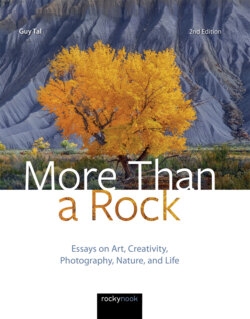Читать книгу More Than a Rock, 2nd Edition - Guy Tal - Страница 17
На сайте Литреса книга снята с продажи.
Lie Like You Mean It8
ОглавлениеWhy do most great pictures look uncontrived? Why do photographers bother with the deception, especially since it so often requires the hardest work of all? The answer is, I think, that the deception is necessary if the goal of art is to be reached . . .
—Robert Adams
I once complimented a fellow photographer on an image of remarkable beauty—a pristine alpine lake reflecting a blazing red sky and rugged granite peaks. It looked so peaceful and inviting, the kind of place that might move a person to find a quiet perch and conjure up poetry. The photographer’s response was casual and blunt, “Oh, the mosquitoes were terrible up there.” Not long after, at a formal dinner party, I sat next to someone who turned out to be a mathematics professor. We had a couple of glasses of wine and I inquired about his work. Rather than mathematics, I got an earful about university politics and the challenges of securing grants. He then was silent for a moment as if contemplating a difficult question while looking wistfully into his wine glass, before saying quietly, “People don’t realize that math is so beautiful.”
I realized then that the two conversations, although seemingly unrelated, were, in fact, very similar. We tend to glamorize what we do, even knowing that, when considered objectively, our characterizations may at times depart from the realities of doing it. Even in the face of the grand, the mysterious, and the majestic, it is all too easy to miss the thread of significance woven into the fabric of what is always a much larger experience, and never quite so pure and obvious as we might like our audience to believe.
I remember being criticized for suggesting that the answer to the not-uncommon question “Did it really look like that?” is almost always, “No.” In fact, most photographers I know would probably respond with a very confident “Yes,” without giving it a second thought. To be fair, most of them truly believe the answer is “yes” because, while others may not have perceived the experience in the same way, in their minds it really did look—and more importantly, feel—“like that.”
Far be it from me to criticize anyone for manufacturing experiences not strictly founded in reality. In fact, I believe it to be an essential characteristic of any art. Indeed, a good analogy can be found in writing: some writings are fictional, some are poetic, some are factual, and some are interpretive. The existence of one does not invalidate the others.
My own work, by this analogy, is more akin to Nature Writing than to fiction or factual accounts. It is a blend of inspiration derived from true experience and of my inner stories, emotions, and thoughts. In that sense my stories also are like journal entries, describing real events but doing so in a subjective way. My times in the wild influence my thoughts, and I consider natural aesthetics not as goals in themselves, but as means to personally expressive ends.
In this also lies the commonality I found between the photographer and the mathematician I spoke with. Their personal and complex relationship with their work allowed them to draw a clear line between the mundane and the transcendent aspects of what they do. Having found ways to relate their professional pursuits to deeper inner significance, they are able to filter and compartmentalize the two as distinct and separate dimensions of the same experience that can be easily set apart, even if the separation may not be intuitive or obvious to others. In using the terms of their formal pursuits to express ulterior meaning, they transcend objective truth and lie like artists do, in the sense expressed by Picasso: lies that make us realize the truth—not objective, measurable, truth, but an expression of subjective, inner truth.
Regrettably there are also those photographers who lie about lying; those who follow trends and recipes without questioning, contemplating, or contributing anything of their own; those who try to pass off their work as representing objective reality because it’s what their audience wants to believe, rather than take the time to educate their audience about the nuances of art and the many things that one can express in a photograph beyond “this is what it looked like.”
Anyone harboring an artistic spirit likely can intuitively distinguish those works conceived of passion, contemplation, creativity, and love—works that express significance beyond a misplaced allegiance to literal representation obscured by a veneer of hype and artificiality. The most effective art tells a truth, not the truth, and does so not by being descriptive in a literal sense, but by offering metaphors for the (true) state of mind of the artist, which would otherwise be not just unknown, but unknowable to anyone else.
If you want your work to represent your own truth, then you should embrace the lies and lie like you mean it! No product of human conception can contain all tangible dimensions of an experience; and even if it could, it would not be of much use as art since even the most complete objective account explicitly leaves out the subjective touch of a creative artist. In my mind, art and objectivity do not mix. An artist is one who creates meaning, who expresses a significance born of their own mind, and who relays their own inspiration in their work. Postulating about what amounts to “objective reality” (whether true or not) is the business of scientists, journalists, judges, and priests. Artists work in the subjective.
